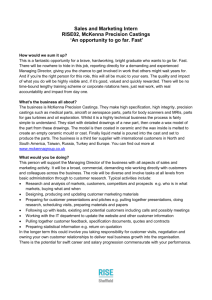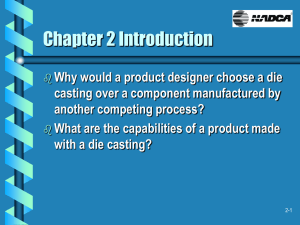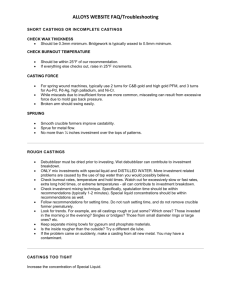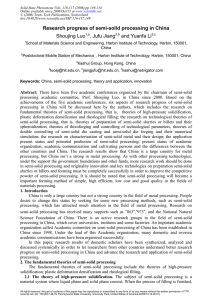Highlights Today - foundry informatics centre
advertisement
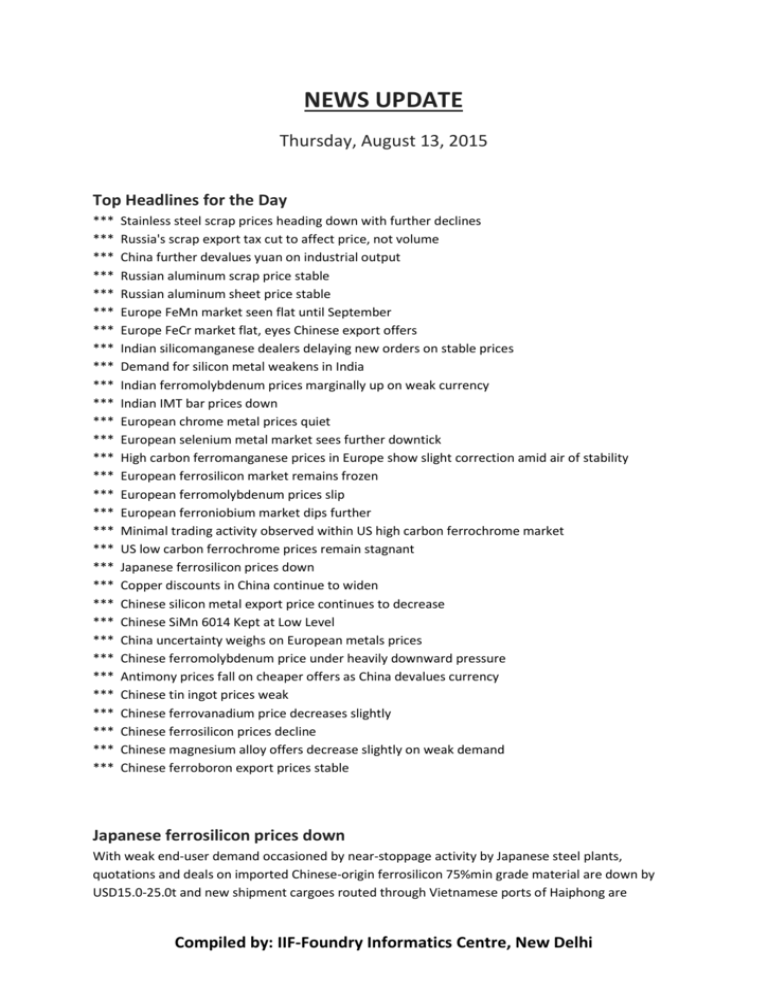
NEWS UPDATE Thursday, August 13, 2015 Top Headlines for the Day *** *** *** *** *** *** *** *** *** *** *** *** *** *** *** *** *** *** *** *** *** *** *** *** *** *** *** *** *** *** *** Stainless steel scrap prices heading down with further declines Russia's scrap export tax cut to affect price, not volume China further devalues yuan on industrial output Russian aluminum scrap price stable Russian aluminum sheet price stable Europe FeMn market seen flat until September Europe FeCr market flat, eyes Chinese export offers Indian silicomanganese dealers delaying new orders on stable prices Demand for silicon metal weakens in India Indian ferromolybdenum prices marginally up on weak currency Indian IMT bar prices down European chrome metal prices quiet European selenium metal market sees further downtick High carbon ferromanganese prices in Europe show slight correction amid air of stability European ferrosilicon market remains frozen European ferromolybdenum prices slip European ferroniobium market dips further Minimal trading activity observed within US high carbon ferrochrome market US low carbon ferrochrome prices remain stagnant Japanese ferrosilicon prices down Copper discounts in China continue to widen Chinese silicon metal export price continues to decrease Chinese SiMn 6014 Kept at Low Level China uncertainty weighs on European metals prices Chinese ferromolybdenum price under heavily downward pressure Antimony prices fall on cheaper offers as China devalues currency Chinese tin ingot prices weak Chinese ferrovanadium price decreases slightly Chinese ferrosilicon prices decline Chinese magnesium alloy offers decrease slightly on weak demand Chinese ferroboron export prices stable Japanese ferrosilicon prices down With weak end-user demand occasioned by near-stoppage activity by Japanese steel plants, quotations and deals on imported Chinese-origin ferrosilicon 75%min grade material are down by USD15.0-25.0t and new shipment cargoes routed through Vietnamese ports of Haiphong are Compiled by: IIF-Foundry Informatics Centre, New Delhi confirmed to have been concluded USD1,075t CIF Japanese ports. A 500t-ferrosilicon 75%min grade material was reportedly concluded to a Japanese end-user at USD1,075t CIF Japanese ports with delivery expected by early September, a new low bids following mainstream deals in the past week. Demand for silicon metal weakens in India Chinese silicon metal price kept dropping, and the demand in local market remained weak, and thus, Indian silicon metal market was in thin trading early this week. Market participants claimed that RMB depreciated sharply against US dollars on Tuesday and Wednesday and the offer for silicon metal from China decreased further with that for 5-5-3 getting lower from around USD1,620-1,640t CIF Nhava Sheva last week to USD1,590-1,610t CIF Nhava Sheva. Chinese ferrosilicon prices decline Sources reported that Chinese ferrosilicon market sees weakening demand and sliding prices. Currently, prices for ferrosilicon 72%min natural blocks drop to RMB4,550-4,650t USD707-722t EXW DA, down by RMB50t USD7.77t from last week, and those for ferrosilicon 75%min natural blocks decrease to RMB4,900-5,000t USD761-777t, down by RMB50t USD7.77t from last week. Chinese SiMn 6014 Kept at Low Level In recent period, price of silicon manganese 6014 also kept in poor performance given sluggish demand. In fact, low sale price made shutdown situation of silicon manganese in south area become worse. In Guangxi and Chongqing, price of 6014 concentrated on RMB4,050-5,150/mt without tax while RMB4,100-4,200/mt for Hunan and Guizhou. In Henan, price of 6014 dropped to RMB4,1504,200/mt. Given traditional slack season in August, the movement of alloy market would be hard to show good shape. Despite prices already touched the bottom line, the future market of silicon manganese would still be not optimistic amid slowing growth of economy in China Industry hails Haryana's new industrial policy Industry body CII on Tuesday hailed Haryana's new 'Enterprises Promotion Policy 2015' and described it as "progressive one". CII Northern Region Chairman and Somany Ceramics CMD Shreekant Somany said, "The focus of the policy is on enhancing the ease of doing business in Haryana and make it an investment hub both domestically and globally, with the aim to ensure the overall socio-economic development of the state." He added, "CII is pleased to note that a lot of its key recommendations like efforts towards effective single window clearance mechanism focus on development and support to MSMEs, entrepreneurship, skill building and R&D facilitation, rationalisation of labour laws and minimal or no Inspection regime, need for online grievance redressal mechanisms have been considered positively." A statement from the industry body further said, "CII hopes that the chief minister led Economic Advisory Council (EAC) would monitor and speed up the implementation of necessary revisions." CII Haryana state council chairman and Satyam auto components managing director Sameer Munjal said, "The policy is progressive as it focuses on attracting investments & retaining the existing Compiled by: IIF-Foundry Informatics Centre, New Delhi investments by leveraging its strengths through sustained aggressive promotional strategies complemented by a globally competitive and sustainable business environment." CII Haryana state council vice chairman and Maruti Suzuki executive director Rajeev Gandhi said, "With the government playing the role of a facilitator and a catalyst, the policy will provide an eco-system that encourages the minimum government and maximum governance model of the government." Chinese Aluminum prices may remain under pressure in medium term Aluminum prices in China will remain under downward pressure from persistent supply glut in the medium-to-long term, Shanghai Metals Market foresees. Supply and demand imbalance will worsen due to record high aluminum production and slowing downstream consumption from economic downturn, SMM understands. Aluminum stocks on the SHFE have been increasing since March, hitting 321,177 tons as of August 7, a reflection of poor consumption. The most active aluminum contract on the SHFE hit a six-year low on August 11, down 11.4% from high level seen on May 6. Price volatility in Iron Ore returns in July July recorded some of the largest-ever one day moves in The Steel Index (TSI) benchmark 62% Fe iron ore index as prices came under renewed pressure. The monthly average of the index was down over 17% compared with June. The latest Chinese import data showed a 6% increase in the country’s June imports of the raw material. Within this, Australian iron ore, accounting for two thirds, increased 8% m-o-m. Chaos in China’s volatile equities markets fed through into the “real economy” as well as affecting steel markets, largely through the effect market turbulence had on commodities futures (including those for steel and iron ore). The China manufacturing PMI by Caixin and the official government both signalled contraction in output again. The iron ore derivatives market saw another record month of trade, with one day alone seeing more than 15 million tons cleared through the Singapore Exchange (SGX). The total volume across SGX and the CME Group in July exceeded 124 million tons, 35.5% higher than last month. The Benefits of Semi-Solid Casting for Aluminum Alloys Semi-solid metalcasting (SSM) was developed in the 1970s and became a commercial process for thixocasting (billet re-heating) in the 1990s, and for rheocasting (generating the semi-solid slurry directly from the liquid) in the 2000s. However, despite significant technical and economic advantages, as pointed out recently by Jorstad(1), SSM has never advanced to become the major metalcasting process anticipated by so many early investigators. Certainly there have been a number of obstacles to the commercialization of SSM, such as the original thixocasting process being relatively expensive, early rheocasting processes not being fully competitive, along with improvements made to already-facilitated competing casting processes (squeeze casting, conventional diecasting, and high vacuum diecasting.) We agree with Jorstad and suggest that semi-solid casting still has much to offer. The global economic downturn in the late 2000s resulted in overcapacity of existing processes and a reluctance to invest in new processes, but the economic recovery makes it an ideal time to reexamine the benefits of semi-solid casting. Certainly large-volume buyers of castings, such as automotive Compiled by: IIF-Foundry Informatics Centre, New Delhi companies, are under pressure to reduce casting weight to improve fuel economy and reduce CO2 emissions. So, our purpose here is to re-examine semi-solid casting and review the benefits of the process. There are a number of advantages to producing castings in uncoated metal molds, including the production of excellent surface finishes, close dimensional tolerances, and probably most important, fine-scale microstructures (due to rapid heat extraction.) However, the high cooling rates experienced in metal molds also present processing difficulties, as the liquid metal needs to fill the cavity quickly before the onset of solidification. To produce high-quality castings, Campbell(2) has suggested that cavity-filling speeds should not be greater than 0.5 m/sec, thereby establishing a limit on the minimum wall thickness and the maximum casting size that can be produced by gravity pouring or low-pressure processes. In contrast, high-pressure diecasting ignores Campbell’s rule on the maximum cavity-filling speed and sprays the liquid metal into the die at extremely high rates (30-50 m/sec.) While this allows the diecasting process to produce extremely thin-walled castings (as thin as 1-2 mm), the turbulent diefilling process tends to trap large quantities of air, resulting in high levels of detrimental residual porosity in the castings. Semi-solid metalcasting maintains all the advantages of diecasting, while eliminating all (or most) of the residual porosity, thereby producing high-quality, thin-walled castings with excellent mechanical properties. Instead of using a fully liquid metal to produce the castings, semi-solid casting uses a high-viscosity feed material that is about 50% solid and 50% liquid. The fluid behavior of semi-solid materials is displayed in Figure 1, which shows the impact of solid content on apparent viscosity. While low solid contents have only a small impact on viscosity, increasing the solid content above 40% or so significantly increases viscosity. This difference in flow behavior is demonstrated by the partially filled plate castings shown in Figure 2. The casting on the left was partially filled at high speed with fully liquid aluminum, and the turbulent filling behavior is evident. However, when the plate cavity was filled at the identical injection speed with semi-solid metal, the filling behavior became laminar. The difference is due to the high viscosity of the semi-solid alloy, and this controlled die-filling behavior allows SSM to produce thin-walled, complex-shaped castings with excellent mechanical and functional performance. Research(4) has confirmed that the high viscosity of semi-solid alloys can indeed minimize the number of defects in castings. Figure 3 shows the impact of solid fraction and filling speed on defect formation in castings (the defects being identified by x-ray.) The researchers found that defect-free castings could be produced only with fully liquid aluminum (solid fraction of 0%) when the cavity injection speed was 0.5 m/sec; defects were formed at higher filling speeds. Note that this is in agreement with the maximum die-filling speed suggested by Campbell(2.) However, as the solid fraction of the feed material was increased, the maximum die-filling speed at which defects were avoided also increased. For example, at a solid content of 30%, the maximum die-filling speed to avoid defects increased to 1.5 m/sec. Of most importance commercially is the alloy containing 50% solid, and the researchers showed that defect-free castings could be produced at an injection speed of 3.5 m/sec (seven times faster than for fully liquid aluminum.) This ability to fill thin sections while avoiding defects is significant, as thin-walled castings are obviously of great commercial interest. Similar to conventional diecasting, semi-solid casting is capable of producing ultra-thin walled castings in the range of 1-2 mm. While such sections require very high filling velocities, well above those generally considered stable, such velocities appear to be Compiled by: IIF-Foundry Informatics Centre, New Delhi easily tolerated by semi-solid slurries, allowing such ultra-thin walled castings to be filled without defects.(1.) For example, researchers(5) reported on the production of such a casting about 125X200 mm in size, with a wall thickness of 1 mm (Figure 4.) However, it’s worth noting that such ultra-thin walled castings are not typical, and most commercial semi-solid castings have wall thickness in the range of 2-5 mm. Superior Soundness, Longer Die Life. The combination of controlled die filling by a highly viscous semi-solid material, together with the high intensification pressures used to feed solidification shrinkage, allows the semi-solid process to produce castings of exceptionally high quality, having very low levels of porosity. While conventional high-pressure diecastings typically have porosity levels measurable in whole percentages, and the porosity content of squeeze castings are typically measurable in tenths of a percent, porosity levels in semi-solid castings are typically as low as hundredths of a percent.(1.) Such low porosity levels produce castings with excellent mechanical properties, certainly equal or better in quality and cost than achievable by low-pressure permanent mold or squeeze casting (Table 1.) Therefore, properties that are influenced by porosity and defects, such as elongation(6) and fatigue(7), tend to be much better for SSM than for castings produced by competing processes. In addition, due to the lack of residual porosity, semi-solid castings are fully weldable. Another significant advantage of semi-solid casting is the considerable extension in tool life versus conventional diecasting, and especially compared to squeeze casting. As pointed out by Jorstad(1) for metal-mold casting processes, the number of castings that can be produced before the onset of heat checking (thermal fatigue) and eventual tool failure is a function of two factors: (1) the total heat load placed on the die; and, (2) the temperature difference (∆T) between the tool and the incoming metal. Each of these are discussed below. The heat load imposed on the die occurs as the tool absorbs heat from the solidifying aluminum. The magnitude of the heat load is a function of three factors: the superheat of the liquid, the latent heat of solidification, and the specific heat required to cool the solid casting to its ejection temperature. For squeeze casting, where the fully liquid metal is injected into the die at 730-735°C and the solid casting is ejected around 425-430°C, the magnitude of this heat load is about 900 J/g. The total heat load from conventional diecastings is only slightly lower, due to diecastings typically being thinner in nature. In contrast, the heat load during semi-solid casting is much lower (around 500 J/g), due to the injection temperature for a semi-solid alloy with a solid content of 50% being as low as 575°C. For the same reason, the ∆T between the tool and incoming metal is much smaller for semi-solid casting compared to other metal mold processes. For squeeze casting, the magnitude of the difference is around 480-535°C, for conventional diecasting about 450- 525°C, but it is only 230290°C for semi-solid casting. Because of these differences, the tool life for semi-solid casting is easily double the tool life of conventional diecasting, and three-to-five times that of squeeze casting.(1.) This is of great consequence, as tools for all three high-pressure processes are very expensive (generally ≥$100,000.) SEED Process. For successful semi-solid casting, it is necessary that the solid phase have a nondendritic, globular microstructure. While a great number of different methods have been proposed to produce semi-solid castings, if the goal is to produce high-quality castings, it is necessary to use a process that generates the globular microstructure while treating the liquid metal gently, avoiding the introduction of defects during turbulent processing (such as rapid stirring or mixing.) While thixocasting (billet re-heating) has been shown to be capable of producing extremely high-quality castings(7), commercial competitiveness of thixocasting is hampered the limited number of billet suppliers, along with the high cost associated with the specially processed feed material and the low Compiled by: IIF-Foundry Informatics Centre, New Delhi value of offal. Rheocasting, where the semi-solid slurry is generated directly from the liquid adjacent to the casting machine, has greatly improved competitiveness, but potential users must take care to pick a suitable rheocasting process. With the SEED process (Swirled Enthalpy Equilibration Device), castings are produced with minimal levels of turbulence.(9,10.) As shown schematically in Figure 5, the liquid alloy is melted and held at a superheat of about 30°C. A controlled amount of the melt is transferred to a coated crucible, and the wall thickness of the crucible is chosen so that the melt is chilled to a temperature within the semi-solid temperature range. Then, the crucible is gently swirled, to distribute the solid phase uniformly within the crucible (while avoiding turbulent mixing.) Once the slug is at the correct temperature (and solid fraction), the slug is ejected from the crucible and controlled parameters used to inject it into the die cavity. In summary, there are a significant number of benefits to semi-solid casting that should be of interest to the producers and users of high-quality aluminum castings,(1.) including: • Castings can be produced without splashing, oxide formation and entrapment of air, as long as the rheocasting process is carefully chosen. • The viscous semi-solid alloy flows only when forced, and will not cascade into lower cavities of the die. • High pressures (up to 100 MPa) can allow the complete feeding of solidification shrinkage porosity. • SSM cast products have exceptional soundness, and therefore have excellent strength, ductility and fatigue resistance, and are fully weldable. • The fast cavity-filling time allows semi-solid alloys to fill extremely thin sections (2- 3 mm and less), minimizing casting weight. • SSM reduces cycle time, thereby maximizing productivity. • SSM significantly extends tool life, so a die life of hundreds of thousands of shots is possible. To succeed commercially, semi-solid casters must take advantage of the cost-saving features available with the processes, which include the use of low-cost feed materials, reduced metal content (through the use of thin-walled castings), reduced machining via near-net shape processing, reduced porosity leading to better mechanical properties (especially elongation and fatigue), the elimination of impregnation for pressure-tight castings, minimization of scrap, and extended die life. However, as noted, it’s critical that the producers of semi-solid castings have technically and economically successful product launches, and so must pick rheocasting processes that minimize turbulence during the production of the semi-solid slurry and so are capable of producing high quality castings. The SEED process is such a rheocasting process(9), as it optimizes metal quality during both the production of the slurry and during the casting process itself. So, in the authors’ opinions, if casters pay attention to the details and follow established quality practices, the age of semi-solid casting can still be realized. Compiled by: IIF-Foundry Informatics Centre, New Delhi

